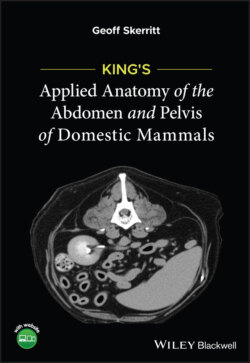Читать книгу King's Applied Anatomy of the Abdomen and Pelvis of Domestic Mammals - Geoff Skerritt - Страница 21
1.3.4 External abdominal oblique muscle (Figures 1.3–1.5)
ОглавлениеFigure 1.3 Lateral view of the inguinal region of the horse left external oblique abdominal muscle.The spermatic sac is seen emerging from the left superficial inguinal ring.The spermatic sac contains the testicle and the spermatic cord (See Figure 15.4).For a definition of the spermatic sac see Section 16.4
Figure 1.4 Ventral view of inguinal region of the horse showing the left and right external abdominal oblique muscles. The arrows indicate the left and right femoral canals, providing exit for the femoral arteries and veins.
Figure 1.5 Lateral view of the abdomen of the ox showing the left external abdominal oblique muscle.
Origin: The lateral surfaces of the ribs caudal to the fourth rib and the lumbodorsal fascia.
Insertion: The linea alba and prepubic tendon.
Structure: Most of the muscle fibres run caudoventrally. At its origin it consists of muscle fibres but towards its insertion caudoventrally it becomes a tendinous aponeurosis. Towards its insertion in the prepubic tendon there is a slit in the aponeurosis; this is the superficial inguinal ring. The slit divides the tendon into an abdominal part cranially and a pelvic part caudally. The caudal edge of the pelvic part of the tendon is the inguinal ligament.
Species variations: The external abdominal oblique muscle of the dog and pig is mainly muscular almost to the dorsal edge of the rectus abdominis muscle. In ruminants there is no origin from the lumbodorsal fascia, but there is an insertion on the tuber coxae. In the ox the aponeurosis of this muscle is extensive. In the horse the external abdominal oblique muscle is very large and inserts onto the femoral fascia, linea alba, tuber coxae and the prepubic tendon.
